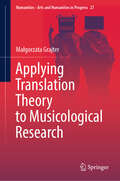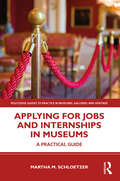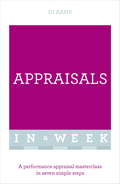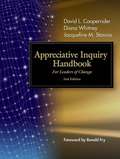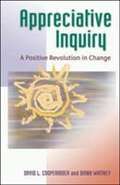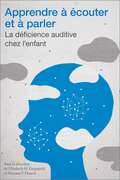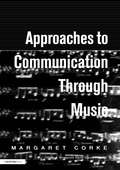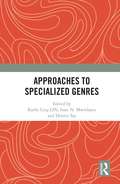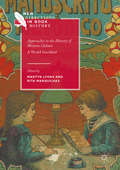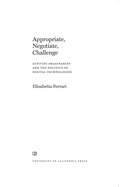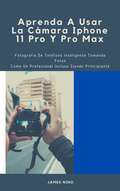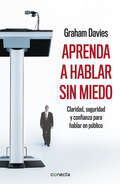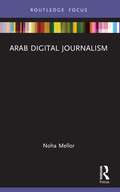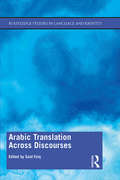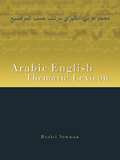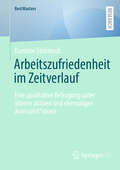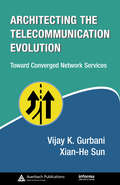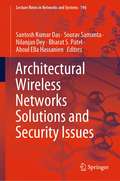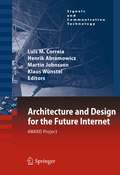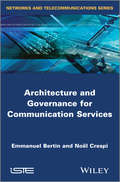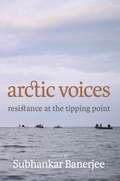- Table View
- List View
Applying Translation Theory to Musicological Research (Numanities - Arts and Humanities in Progress #27)
by Małgorzata GrajterThis monograph lays the foundation for new methodologies of research between music and translation. It is the first such holistic attempt—from the perspective of a musicologist—based on the adaptation of translation theories. Until now, these fields have remained underexplored together. Only recently have the tools developed by translation theory permeated into musical scholarship. Such tools should prove as a promising alternative to those offered by classic musicological studies, particularly in reference to musical arrangement, pop music covers and performance. Theoretical discussion on topics are supported by case studies. This text appeals to musicologists and musicians as well as experts in the field of translation theory who are interested in expanding their field of inquiry.
Applying for Jobs and Internships in Museums: A Practical Guide (Routledge Guides to Practice in Museums, Galleries and Heritage)
by Martha M. SchloetzerApplying for Jobs and Internships in Museums offers a straightforward approach to applying for positions within a museum. Martha M. Schloetzer provides practical advice about the application and interview process that will prepare emerging museum professionals as they approach the profession. From reviewing job and internship postings to developing a solid resume and writing distinctive cover letters, this guide provides practical, sound advice for museum job seekers. Schloetzer integrates the stories of successful and unsuccessful interns and job applicants throughout the book’s narrative, and recognizing the additional challenges faced by non-US nationals, the book also offers information specifically for international students seeking work experience in US museums. The insider information included in Applying for Jobs and Internships in Museums makes it a key resource for both a US and international audience interested in gaining museum experience in the US. It will be of particular interest to college-level and graduate school students, as well as recent graduates. The guide can also serve as a reference in the classroom, helping professors and instructors prepare students for the job search ahead.
Appraisals In A Week: A Performance Appraisal Masterclass In Seven Simple Steps
by Di KampEffective appraisals just got easierAppraisals are often seen as an isolated and time-consuming round of paperwork that everyone has to engage in and few see any point to. If we were to truly recognize the potential and intended value of appraisals, they would be regarded completely differently.The original intention of an appraisal system is to encourage and develop the staff of the organization, so that they all perform to their highest potential. Properly implemented and used, appraisals will help you, if you are a manager, to ensure that your staff are as effective as possible in their work, and thereby to make your area of work a powerful contributing factor to the success of the organization.Appraisals can also make your job as a manager easier, because they give you the opportunity and framework to encourage and develop your staff. This results in a team of people who feel valued and supported, and who know that their work makes a positive difference to the organization as a whole. As a manager, you can then spend less time and energy on pushing and controlling your team, and more time on the work that moves things forward and is more satisfying.By the end of the final chapter, you will see how appraisals can make a positive difference to youas a manager, your staff as individuals, and the organization as a whole. Sunday: Why appraise?Monday: Formulating a successful appraisalTuesday: The appraiser's role 1: setting the frameworkWednesday: The appraiser's role 2: attitudes and approachesThursday: The interview 1: reviewing achievementFriday: The interview 2: looking aheadSaturday: Completing the appraisal: after the interview
Appraisals In A Week: A Performance Appraisal Masterclass In Seven Simple Steps
by Di KampEffective appraisals just got easierAppraisals are often seen as an isolated and time-consuming round of paperwork that everyone has to engage in and few see any point to. If we were to truly recognize the potential and intended value of appraisals, they would be regarded completely differently.The original intention of an appraisal system is to encourage and develop the staff of the organization, so that they all perform to their highest potential. Properly implemented and used, appraisals will help you, if you are a manager, to ensure that your staff are as effective as possible in their work, and thereby to make your area of work a powerful contributing factor to the success of the organization.Appraisals can also make your job as a manager easier, because they give you the opportunity and framework to encourage and develop your staff. This results in a team of people who feel valued and supported, and who know that their work makes a positive difference to the organization as a whole. As a manager, you can then spend less time and energy on pushing and controlling your team, and more time on the work that moves things forward and is more satisfying.By the end of the final chapter, you will see how appraisals can make a positive difference to youas a manager, your staff as individuals, and the organization as a whole. Sunday: Why appraise?Monday: Formulating a successful appraisalTuesday: The appraiser's role 1: setting the frameworkWednesday: The appraiser's role 2: attitudes and approachesThursday: The interview 1: reviewing achievementFriday: The interview 2: looking aheadSaturday: Completing the appraisal: after the interview
Appreciative Inquiry Handbook: For Leaders of Change (2nd edition)
by Diana Whitney David L. Cooperrider Jacqueline M. StavrosOne of today's most popular change methods, Appreciative Inquiry (AI) has been used to undertake transformational initiatives in dozens of organizations, ranging from McDonald's to the U.S. Navy to Save the Children. The assumption of AI is simple. Every organization has something that works right -- things that give it life when it is vital, effective, and successful. AI begins by identifying this positive core and connecting organizational visions, plans, and structures to it in ways that heighten energy and inspire action for change.
Appreciative Inquiry: A Positive Revolution in Change
by Diana Whitney David L. CooperriderThis short, practical guide offers an approach to organizational change based on the possibility of a more desirable future, experience with the whole system, and activities that signal "something different is happening this time."
Apprendre à écouter et à parler: La déficience auditive chez l’enfant (Éducation)
by Elizabeth M. Fitzpatrick et Suzanne P. DoucetLa déficience auditive a un impact considérable sur plusieurs aspects du développement de l’enfant, y compris sur les habiletés de communication, l’apprentissage scolaire, les habiletés sociales et, au final, la qualité de vie de l’enfant et de sa famille. Par le passé, la déficience auditive présentait des obstacles presque insurmontables. De nos jours, la technologie et les techniques d’intervention permettent de mieux répondre aux besoins des enfants ayant une perte d’audition, et donc de les aider à devenir des membres à part entière de la société. Le dépistage précoce et la technologie d’amplification auditive font en sorte que nous vivons à présent une période charnière dans le domaine de l’éducation des enfants ayant une surdité. Cette éducation nécessite tout de même une intervention spécialisée de la part d’une équipe de professionnels, et ce, en collaboration étroite avec les parents. Compte tenu des approches novatrices dans le développement de méthodes d’apprentissage du langage verbal chez les enfants présentant des troubles de l’audition, la communauté internationale mise davantage sur la formation et le perfectionnement des professionnels. Appuyées par une équipe multidisciplinaire d’experts dans le domaine, les deux auteures abordent les principales problématiques médicales, technologiques, éducatives et sociales liées à ces troubles.Publié en français
Approaches to Communication through Music
by Margaret CorkeOne of the ways forward when working with those who have little or no speech, or limited comprehension of language, is to use music. In this book tried and tested approaches and activities devised to promote the development of communication and social interaction at a fundamental level are clearly set out. The ethos behind this manual is a person-centered approach, within a structured framework and allowing for differentiation and improvisation according to the learner's individual needs and developmental levels. This is a practical guide that contains lots of ideas and original activities for the specialist and non-specialist alike. It provides original songs and music scores, activities and games, and suggestions for group work for learners at a variety of levels.This book will be helpful to teachers, carers, therapists and parents who work or live with people with severe or profound and multiple learning difficulties. Music teachers and coordinators working in mainstream early years and primary education will also find the songs and activities useful.
Approaches to Discourse in Dementia
by Nicole Muller Jacqueline A. GuendouziThe qualitative analysis of naturally occurring discourse in neurogenic communication disorders, specifically in dementia studies, has experienced recent burgeoning interest from wide-ranging disciplines. This multidisciplinarity has been exciting, but has added contextual confusion. This book advances the study of discourse in dementia by systematically exploring and applying different approaches to the same free conversational data sets, collected and transcribed by the authors. The applied methodologies and theories comprise a useful sourcebook for students, researchers, and practitioners alike.
Approaches to Specialized Genres
by Dennis Tay Kathy Ling Lin Isaac N. MwinlaaruApproaches to Specialized Genres provides a timely update of the field of genre studies, with 14 cutting-edge contributions split into five sections using and integrating an exceptionally wide variety of methods and perspectives (such as ESP genre research, corpus linguistics, systemic functional linguistics, ethnographic and multimodal research) to analyse genres in written, spoken, visual and auditory modes across a multiplicity of pedagogic, professional and digital settings. It highlights and illustrates the growing trend of a multiperspective and inter-theoretic approach to genre studies and demonstrates how such methodological rigour can extend our knowledge of language, in general, and genres, in particular. It also examines a rich variety of underexplored genres such as the digital genre of synchronous videoconferencing, instructional slides, video ads, engineers’ training log book entries, the narrative story genres, fundraising letters and retraction notices. It demonstrates not only the prominent value of genre research, but wide applications of genre knowledge in various educational and professional domains. The book brings together experts spreading across the world, including countries in South-East Asia, Europe, America, West Africa and South America. Accordingly, it will appeal to readers of diversified socio-cultural backgrounds working in all the aforementioned inter-related fields of applied linguistics and communication studies.
Approaches to the History of Written Culture: A World Inscribed (New Directions in Book History)
by Martyn Lyons Rita MarquilhasThis book investigates the history of writing as a cultural practice in a variety of contexts and periods. It analyses the rituals and practices determining intimate or 'ordinary' writing as well as bureaucratic and religious writing. From the inscribed images of 'pre-literate' societies, to the democratization of writing in the modern era, access to writing technology and its public and private uses are examined. In ten studies, presented by leading historians of scribal culture from seven countries, the book investigates the uses of writing in non-alphabetical as well as alphabetical script, in societies ranging from Native America and ancient Korea to modern Europe. The authors emphasise the material characteristics of writing, and in so doing they pose questions about the definition of writing itself. Drawing on expertise in various disciplines, they give an up-to-date account of the current state of knowledge in a field at the forefront of 'Book History'.
Appropriate, Negotiate, Challenge: Activist Imaginaries and the Politics of Digital Technologies
by Dr. Elisabetta FerrariActivists use digital technologies to communicate, coordinate, and organize for social change. But these big corporate digital platforms are also used to spread disinformation, racism, and abuse. Appropriate, Negotiate, Challenge investigates the relationship between activism and technology, focusing on how activists think and talk about technology’s role in social change and what this tells us about the politics of digital technologies. Researching movements in Italy, Hungary, and the United States, Elisabetta Ferrari examines how leftist activists construct technological imaginaries that appropriate, negotiate, and challenge Silicon Valley’s vision of technology. She argues that these imaginaries reflect and shape the politics of social movements: they matter for how activists think about their political possibilities. Ultimately, Ferrari centers the political and imaginative work that activists need to perform in order to navigate the politics of mainstream digital technologies.
Aprenda A Usar La Cámara Iphone 11 Pro Y Pro Max: Fotografía De Teléfono Inteligente Tomando Fotos Como Un Profesional Incluso Siendo Principiante
by James Nino*****************Aprenda a usar la cámara del iPhone 11 Pro y Pro Max***************** La cámara del iPhone tiene tantas funciones y trucos ocultos que probablemente no conozca y solo un libro como este puede ayudarle a descubrir esas funciones ocultas. Si tiene un iPhone 11 Pro y quiere poder tomar fotos impresionantes con él, este libro es para usted. Las tres cámaras que sobresalen de la parte posterior del iPhone 11 Pro son increíbles, pero requerirán que domine la configuración de la cámara para poder usarla para capturar excelentes tomas, por lo que debería pedir este libro de inmediato porque le dirá cómo hacer precisamente eso. Muy a menudo, los manuales y la guía de usuario que acompañan a los dispositivos tienden a ser básicos al brindar los mejores trucos y consejos necesarios para obtener lo mejor de dichos dispositivos, por lo que este libro se escribió para ayudarlo a aprovechar al máximo la aplicación de la cámara del iPhone 11 Pro. En este libro aprenderá; • Cómo usar el iPhone 11 Pro para tomar selfies • El significado de slofie, QuickTake, Burst y cómo mejoran la fotografía de su iPhone • Por qué la configuración manual de la cámara puede mejorar la calidad de la imagen • Cómo acceder a algunas funciones de cámara ocultas que probablemente no esperaba que tuviera la cámara de un teléfono • Las diferentes funciones de las tres lentes y cómo debe usarlas • Por qué no debería utilizar el zoom digital y utilizar el zoom óptico en su lugar para sacar el máximo partido a sus fotografías. Este libro muestra muchas más funciones de las que esperaría encontrar en un teléfono y lo ayuda a utilizar mejor su iPhone 11 Pro la próxima vez que vaya de viaje, visite el aeropuerto, se vaya de vacaciones, capture momentos importantes y documente las diferentes etapas de la vida del niño.
Aprenda a hablar sin miedo
by Graham Davies«No conozco a nadie que pueda ostentar el título de "coach de las presentaciones" con más méritos que Graham.»Daniel Finklestein, director ejecutivo, The Times«Tanto si es usted primer ministro como si es director ejecutivo, o alguien que necesita causar impacto en los demás, debe leer este libro, innovador y crítico, de Graham Davies.»Neil Sherlock, socio, KPMG«Sinceramente, este libro me irrita, porque me encantaría que Graham lo hubiera escrito hace veinte años. De haber sido así, quizá no habría tenido que pasarme innumerables horas torturado por inversores de banca que creen que "presentar" significa leer en voz alta todas las palabras que aparecen en sus diapositivas».Richard Klein, director general, Bank of America Merrill Lynch«Nunca más volverá a cometer el delito de aburrir a su audiencia con interminables frases cortas.»Penny Philpot, vicepresidente, Worldwide Partner Services, Oracle«Graham Davies es un maestro del humor que demuestra que la mejor manera de exponer un asunto serio es contando un buen chiste.»Boris Johnson, alcalde de Londres
Aprenda a hablar sin miedo: Claridad, seguridad y confianza para hablar en público
by Graham DaviesLa comunicación es la clave para el éxito. Descubra el método para hablar con seguridad y convencer con sus presentaciones. Seguramente detesta realizar presentaciones. Y probablemente también detesta asistir a ellas. ¿Por qué? Porque la mayoría resultan largas, aburridas... y van acompañadas por el consabido PowerPoint. Tanto si se dirige a una sola persona sentada frente a usted como si habla ante un auditorio repleto, en el fondo lo que importa es lo que diga, y cómo lo diga. Aprenda a hablar sin miedo le enseña a comunicar con claridad y confianza, y a dejar huella en todas las situaciones en las que deba expresarse en público. Aprenderá un método único, en cinco pasos, y válido para todo tipo de exposiciones en el ámbito empresarial, desde presentaciones a gran escala hasta reuniones con un solo cliente. Reseñas:«No conozco a nadie que pueda ostentar el título de "coach de las presentaciones" con más méritos que Graham.»Daniel Finklestein, director ejecutivo, The Times «Tanto si es usted primer ministro como si es director ejecutivo, o alguien que necesita causar impacto en los demás, debe leer este libro, innovador y crítico, de Graham Davies.»Neil Sherlock, socio, KPMG «Sinceramente, este libro me irrita, porque me encantaría que Graham lo hubiera escrito hace veinte años. De haber sido así, quizá no habría tenido que pasarme innumerables horas torturado por inversores de banca que creen que "presentar" significa leer en voz alta todas las palabras que aparecen en sus diapositivas.»Richard Klein, director general, Bank of America Merrill Lynch «Nunca más volverá a cometer el delito de aburrir a su audiencia con interminables frases cortas.»Penny Philpot, vicepresidente, Worldwide Partner Services, Oracle «Graham Davies es un maestro del humor que demuestra que la mejor manera de exponer un asunto serio es contando un buen chiste.»Boris Johnson, Presidente de Reino Unido
Arab Digital Journalism (Disruptions)
by Noha MellorResponding to urgent calls to de-westernise Media and Journalism Studies and shed light on local agency, this book examines digital journalistic practices in the Arab region, exploring how Arab journalists understand their roles and how digital technologies in Arab newsrooms are used to influence public opinion. Drawing on tens of articles penned by Arab media professionals and scholars, supplemented with informal conversations with journalists, this book reviews the historical development of digital journalism in the region and individual journalists’ perceptions of this development. While technology has provided a new platform for citizens and powerful agents to exchange views, this text examines how it has simultaneously allowed Arab states and authorities to conduct surveillance on journalists, curtail the rise of citizen journalism, and maintain offline hierarchal forms of political, economic, and cultural powers. Mellor also explores how digital technology serves to cement Western hegemony of the information world order, with Arab media organisations and audiences judged to be mere recipients, rather than producers, of such information. Arab Digital Journalism offers an important contribution to the emerging field of digital journalism in the Global South and is a valuable resource for students and researchers interested in media, journalism, communication, and development studies.
Arabic Translation Across Discourses (Routledge Studies in Language and Identity)
by Said FaiqA rare contribution to global translation as a ‘cross-cultural-open-concept’, Arabic Translation Across Discourses provides explorations of Arabic translation as an instance of transcultural and translingual encounters (transculguaging). This book examines the application and interrogation of discourses of translation in the translation of discourses (religion, literature, media, politics, technology, community, audiovisual, and automated systems of communication for translation). The contributors provide insights into the concerns and debates of Arabic translation as a tradition with local, yet global dimensions of translation and intercultural studies. This volume will be of great interest to students and researchers of all translation studies, but will also provide a rich source for those studying and researching history, geopolitics, intercultural studies, globalization, and allied disciplines.
Arabic-English Thematic Lexicon
by Daniel L. NewmanThe Arabic-English Thematic Lexicon is an invaluable resource for all learners of Arabic. It contains some 8,000 entries, arranged into themes, including flora and fauna, food and drink, the human body, health care, the family, housing, clothing, education, IT, sports, politics, economics and commerce, the law, media, language, geography, travel, religion, arts, science, and natural resources. Three appendices cover the names of Arab and selected non-Arab regions, countries and capitals, and international organizations. The entries in the Lexicon have been drawn from an extensive corpus of contemporary Standard Arabic vocabulary, based on authentic sources. In addition to verbs, nouns and adjectives, the Lexicon includes phrases and commonly used collocations, providing users with the necessary vocabulary in order to communicate effectively and confidently in both written and spoken standard Arabic. The Lexicon provides an indispensable complement to Arabic grammar instruction and also serves as a useful reference guide for all Arabic language users.
Arabic-English-Arabic-English Translation: Issues and Strategies
by Ronak Husni Daniel L. NewmanArabic-English-Arabic-English Translation: Issues and Strategies is an accessible coursebook for students and practitioners of Arabic-English-Arabic translation. Focusing on the key issues and topics affecting the field, it offers informed guidance on the most effective methods to deal with such problems, enabling users to develop deeper insights and enhance their translation skills. Key features include: A focus on Arabic-English translation in both directions, preparing students for the real-life experiences of practitioners in the field In-depth discussion of the core issues of phraseology, language variation and translation, legal translation and translation technology in Arabic and English translation Authentic sample texts in each chapter, taken from a variety of sources from across the Arabic-speaking world to provide snapshots of real-life language use Source texts followed by examples of possible translation strategies, with extensive commentaries, to showcase the best translation practices and methodologies A range of supporting exercises to enable students to practise their newly acquired knowledge and skills Inclusion of a wide range of themes covering both linguistic and genre issues, offering multidimensional perspectives and depth and breadth in learning List of recommended readings and resources for each of the topics under discussion Comprehensive glossary and bibliography at the back of the book. Lucid and practical in its approach, Arabic-English-Arabic-English Translation: Issues and Strategies will be an indispensable resource for intermediate to advanced students of Arabic. It will also be of great interest to professional translators working in Arabic-English-Arabic translation.
Arbeitszufriedenheit im Zeitverlauf: Eine qualitative Befragung unter älteren aktiven und ehemaligen Journalist*innen (BestMasters)
by Karoline SteinbockIn einer sich wandelnden Medienwelt sind Fragen nach der Zufriedenheit mit der Arbeit und nach Veränderungen der Zufriedenheit im Laufe des Berufslebens von zentraler Bedeutung. Die Forschungsarbeit geht der Frage nach, wie sich die beruflichen Erwartungen, die Veränderungen in der Medienlandschaft und die individuellen Karriereentscheidungen auf die Zufriedenheit ausgewirkt haben. Durch problemzentrierte Interviews mit ehemaligen, aktiven und bereits pensionierten Journalist*innen bietet die Arbeit wertvolle Einblicke, wie sich die Arbeitszufriedenheit unter dem Einfluss von Faktoren wie der digitalen Transformation und der Medienkrise entwickelt. Darüber hinaus wird untersucht, welche weiteren Faktoren die Arbeitszufriedenheit beeinflusst haben. Diese Untersuchung liefert nicht nur praxisrelevante Erkenntnisse für das Personalmanagement und die Organisationsentwicklung in der Medienbranche, sondern bietet auch eine tiefgehende Reflexion über die Arbeitswelt von Journalist*innen in einem sich ständig wandelnden Umfeld.
Architecting the Telecommunication Evolution: Toward Converged Network Services (Informa Telecoms & Media)
by Xian-He Sun Vijay K. GurbaniService-oriented architecture (SOA) uses services as the baseline for developing new architectures and applications, as networks are built specifically to satisfy service requirements. Most services are currently handled over different networks, but newer services will soon require cross-network support. Architecting the Telecommunication Evolution
Architectural Wireless Networks Solutions and Security Issues (Lecture Notes in Networks and Systems #196)
by Aboul Ella Hassanien Nilanjan Dey Santosh Kumar Das Sourav Samanta Bharat S. PatelThis book presents architectural solutions of wireless network and its variations. It basically deals with modeling, analysis, design and enhancement of different architectural parts of wireless network. The main aim of this book is to enhance the applications of wireless network by reducing and controlling its architectural issues. The book discusses efficiency and robustness of wireless network as a platform for communication and data transmission and also discusses some challenges and security issues such as limited hardware resources, unreliable communication, dynamic topology of some wireless networks, vulnerability and unsecure environment. This book is edited for users, academicians and researchers of wireless network. Broadly, topics include modeling of security enhancements, optimization model for network lifetime, modeling of aggregation systems and analyzing of troubleshooting techniques.
Architecture and Design for the Future Internet: 4WARD Project (Signals and Communication Technology)
by Luis M. Correia Klaus Wünstel Henrik Abramowicz Martin JohnssonArchitecture and Design for the Future Internet addresses the Networks of the Future and the Future Internet, focusing on networks aspects, offering both technical and non-technical perspectives. It presents the main findings of 4WARD (Architecture and Design for the Future Internet), a European Integrated Project within Framework Programme 7, which addressed this area from an innovative approach. Today's network architectures are stifling innovation, restricting it mostly to the application level, while the need for structural change is increasingly evident. The absence of adequate facilities to design, optimise and interoperate new networks currently forces a convergence to an architecture that is suboptimal for many applications and that cannot support innovations within itself, the Internet. 4WARD overcomes this impasse through a set of radical architectural approaches, built on a strong mobile and wireless background. The main topics addressed by the book are: the improved ability to design inter-operable and complementary families of network architectures; the enabled co-existence of multiple networks on common platforms through carrier-grade virtualisation for networking resources; the enhanced utility of networks by making them self-managing; the increased robustness and efficiency of networks by leveraging diversity; and the improved application support by a new information-centric paradigm in place of the old host-centric approach. These solutions embrace the full range of technologies, from fibre backbones to wireless and sensor networks.
Architecture and Governance for Communication Services
by Emmanuel Bertin Noël CrespiCommunication services are evolving at an unprecedented rate. No longer limited to interpersonal vocal communication, they now integrate functions such as address books, content sharing and messaging. The emergence of social networks – which may also include these features – is an important element of this transformation. Content services are becoming flagship services themselves, and are sometimes paired up with conversation services. The boundaries between different services are becoming less and less distinct. This book meets the need for a better understanding of communication services, and for a general framework of their description. A detailed overview on service architecture in the Telco, Web and IT worlds is presented, offering a roadmap with explanations on how to improve the architecture and governance of communication service architectures by exploiting the syntax and semantics that are common to different services is clearly outlined. This book also responds to recurring questions about service design, such as the functional scope of enablers or SOA (Service Oriented Architecture) services, the relevance of service composition to the user and collaboration between different services in a converged environment. Many concrete examples from telecoms service providers’ operations illustrate these concepts. Contents 1. Describing Service Architectures. 2. Convergence of Service. 3. Building an Architectural Framework for Telecom Services. 4. Modeling and Case Study. 5. Organizational and Software Applications. About the Authors Emmanuel Bertin is senior service architect at Orange Labs in France. He is the author of more than 40 research papers, and holds more than 10 patents in the area of communication services. Noël Crespi worked at Bouygues Telecom, France Telecom R&D, and then at Nortel Networks where he led the Telephony Programme. He is currently Professor and Head of the Service Architecture Laboratory at Institut Mines-Telecom, Telecom SudParis in France and is the author/co-author of more than 160 research papers and 140 contributions in standardization.
Arctic Voices: Resistance at the Tipping Point
by Subhankar BanerjeeA pristine environment of ecological richness and biodiversity. Home to generations of indigenous people for thousands of years. The location of vast quantities of oil, natural gas and coal. Largely uninhabited and long at the margins of global affairs, in the last decade Arctic Alaska has quickly become the most contested land in recent US history. World-renowned photographer, writer, and activist Subhankar Banerjee brings together first-person narratives from more than thirty prominent activists, writers, and researchers who address issues of climate change, resource war, and human rights with stunning urgency and groundbreaking research. From Gwich'in activist Sarah James's impassioned appeal, "We Are the Ones Who Have Everything to Lose," during the UN Climate Conference in Copenhagen in 2009 to an original piece by acclaimed historian Dan O'Neill about his recent trips to the Yukon Flats fish camps, Arctic Voices is a window into a remarkable region.Other contributors include Seth Kantner, Velma Wallis, Nick Jans, Debbie Miller, Andri Snaer Magnason, George Schaller, George Archibald, Cindy Shogan, and Peter Matthiessen.
